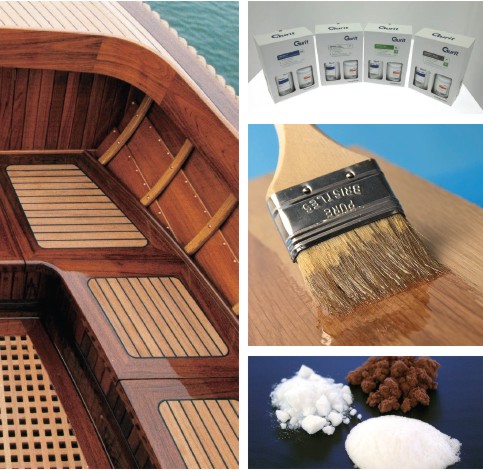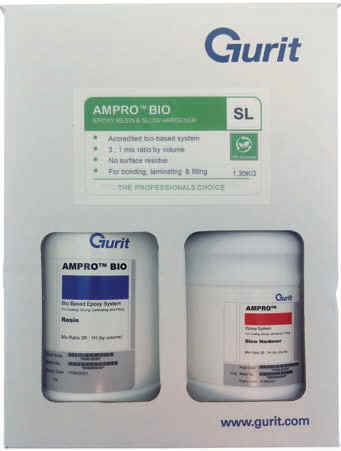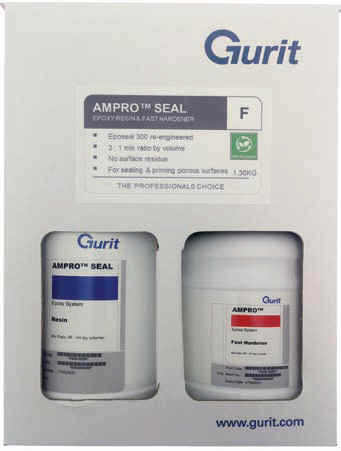
Simple Guide to Epoxies
Techniques for Using AMPRO™ Multi-purpose Epoxy

Introduction
This simple guide is designed to provide you with a straight-forward understanding of the correct use of epoxies and features of the AMPRO™ range. For more detailed information please visit the website at www.gurit.com.
What are Epoxy Resins?
Epoxy systems are supplied as two liquids, a Resin and a Hardener. When these are mixed at the correct ratio a chemical reaction takes place and the mix hardens to form a solid. The time taken for the material to harden depends on the products used, temperature, volume and the "speed" of the hardener. It is critical to understand that proportion of hardener used will not change the speed, and the correct mix ratio must always be observed.
The mixed epoxy can be applied in a liquid form, before hardening, to coat wood or saturate woven glass or carbon reinforcements (fabric) to protect and stiffen.
Epoxies can also be mixed with fillers (additives) to give other characteristics making them into adhesives or filling and fairing mixes.
This adaptability allows them to be used in a wide variety of applications including marine, construction, general DIY and model-making.
AMPRO™ Multi-purpose System
AMPRO™ is an award winning, latest generation multi-purpose epoxy system from Gurit. It is a simple to use, all-purpose epoxy which can be used for bonding, coating, laminating and filling.
AMPRO™ provides a quick and convenient way of using one epoxy system for a wide range of tasks. Key features include:
Professional: boat-builder’s choice for bonding, laminating and filling
Safer: uses lower toxicity chemicals with low hazards
Stronger: more flexible resin matrix ideal for working with wood
Tack-free: no surface residue when cured and does not clog sandpaper
Water-proof: AMPRO™ SILICA has been optimised to withstand the marine environment
Wide over-coating window: up to 4 days later without additional surface preparation
Faster: improved cure at temperatures as low as+5C
Glossier: improved coating performance with reduced surface defects
Cardboard outer packaging: less single use plastics
Greener: accredited, bio-based option using a high content of plant based chemicals
Simplified: 4 systems, inter-changeable hardeners and the same 3:1 mix ratio by volume
1
One System, Many Uses…
AMPRO™ consists of inter-changeable resins, blend-able hardeners and additives for many uses.
The right combination of AMPRO™ products will depend on your application:
| Coating, Sheathing, or Laminating | |
| Filling, Fairing or Bonding |
| |
AMPRO™ | AMPRO™ BIO | AMPRO™SEAL |
|
Low temperature curing |
|||
| Clear coating | |||
| Grain enhancing wood coating | |||
| Bio-based content |
<10% |
40-60% |
40-60% |
| Sealing & priming porous surfaces |
|
||
|
Filling, Fairing or Bonding |
|
Fast |
Slow |
Extra-Slow |
|
| Working time with a brush at 20oC | 1- 2 hours |
4 - 5 hours |
5 - 6 hours |
| 50g pot-life in air at 20oC | ½ hour | 1 hour | 1½ hours |
|
Micro Balloons
|
Glass
|
Micro
|
AMPRO™
|
||
|
Filling & Fairing Mixes
|
Easy to sand, filling and filleting for cosmetic wood applications | ||||
| Water-proof or lowest-cost filler for general applications | |||||
| Hard surface finish filler for hard wearing edges and surfaces | |||||
| Bonding Mixes | General bonding of softwood, brown in colour | ||||
| General bonding of softwood, white in colour | |||||
| Structural bonding of wood or composite, opaque in colour | |||||
AMPRO™ Systems
|
AMPRO ™ |
 |
|
|
AMPRO™ BIO |
 |
|
|
AMPRO™ SEAL |
 |
|
AMPRO™ Fillers for Bonding and Filling Mixes
|
Glass Bubbles |
 |
|
|
Microballoons
|
 |
|
|
Microfibres |
 |
|
|
AMPRO™ Silica |
 |
|
Using Epoxy Systems
The important points to remember when using epoxy systems are:
n Accurate measurement of the resin and hardener components - If the mix ratio of the resin to the hardener is incorrect the epoxy will never cure correctly. There are two methods for measuring the resin and hardener at the correct ratio
By volume using pumps, cups or syringes
2. By weight using digital scales which are accurate and relatively cheap
Note: the mix ratio will be different by volume and by weight.
Mixing of the resin and hardener - Once dispense to the correct ratio, the components must be mixed thoroughly otherwise the system will not cure properly. As a guide, small quantities (approximately 100g) should be mixed well for at least 2 minutes and larger quantities progressively more. Ideally, use a flat mixing stick or pallet knife to mix, paying particular attention to the sides and corners. For adhesive and filler mixes, always mix the resin and hardener first before adding the filler and then mix it again.
Exothermic Heat - When the epoxy resin and hardener are mixed, a chemical reaction begins, which will turn it into a solid material. As part of this reaction heat is generated. The rate of the reaction and amount of heat generated is determined by a number of factors:
- Hardener speed: more rapid curing systems like AMPRO™ with Fast hardener, will generate more heat during this process.
- Temperature: The warmer the epoxy, the faster the chemical reaction occurs and so more heat is generated and the faster the reaction.
- Volume: If the mixed system remains in the mixing pot, the heat cannot escape into the environment and so heats the material around it. The higher the volume the faster and hotter the exotherm. By transferring the mixed epoxy to a shallow container, like a paint tray, the surface area is increased and thus the heat can escape increasing the working time.
Over-coating - it is usual apply multiple layers of epoxy and this can be done in 1 of 2 ways:
-
Within the specified over-coating window where-by subsequent coats are applied "wet on tacky". This means that when the first coat has thickened sufficiently and is not moved or dragged when applying the second, but before the first coat has cured too far to ensure a chemical bond.
-
After the previous coat has fully cured, it will have reacted too far to generate a chemical bond. The time it will take to fully cure will be dependent on the ambient temperature and the hardener speed. However, a sufficient mechanical bond can be achieved by sanding and cleaning the surface and applying a second coat. A range of epoxy compatible solvents are available, both for surface preparation and tool cleaning.
AMPRO™ has been designed to have a robust 4 day over-coating window without further surface preparation.
Finishing - as with all epoxies, for a clear finish that does not become darker over time, we recommend the use of a UV stable varnish to reduce deterioration caused by ultra violet in sunlight and give a hard-wearing, high-gloss surface finish.
Note: for details of the over-coating & cure times, please refer to the product datasheet.
This is only an introduction to Gurit’s retail products and a brief overview on how they can be used. For more information on Gurit’s products please visit the website at www.gurit.com.
Like many chemicals, epoxies can be harmful if used incorrectly. Please read the health and safety information on the data sheet for the product you are using. Gloves, overalls and safety goggles are recommended and when sanding, a dust mask should be worn.
What is the AMPRO™ Range Replacing?
General Purpose: SP 106 and Handipack is replaced with either AMPRO™ or AMPRO™ BIO
|
System |
Colour |
Low Temp. Curing |
Clear Coating |
Wood-grain Enhancing |
Bio-based Content |
Sealing & Priming |
Filling & Bonding |
| SP 106 |
* * * |
N/A |
* * * |
None |
N/A |
* * * * |
|
| Handipack |
* * * * * |
* * * |
None |
* * * |
|||
| AMPRO™ |
* * * * * |
* * * * |
<10% |
* * * * * |
|||
| AMPRO™ BIO |
* * * * |
* * * * * |
40-60% |
* * * * * |
Sealing & Priming Porous Surfaces: Eposeal 300 is replaced by AMPRO™ SEAL
|
System |
Colour |
Low Temp. Curing |
Clear Coating |
Wood-grain Enhancing |
Bio-based Content |
Sealing & Priming |
Filling & Bonding |
| Eposeal 300 |
* * * |
N/A |
N/A |
None |
* * * * |
N/A |
|
| AMPRO™ SEAL |
* * * |
40-60% |
* * * * |
* NOTE: For a clear finish that does not become darker over time, we recommend the use of a UV stable varnish to reduce deterioration caused by ultra violet in sunlight and give a hard-wearing, high-gloss surface finish
* = Very Poor * * = Poor * * * = Average * * * * = Good * * * * * = Excellent


 Crispy 520 on the water
Crispy 520 on the water
 Simple Guide to Epoxies
Simple Guide to Epoxies
 Idea 850 in Poland
Idea 850 in Poland



